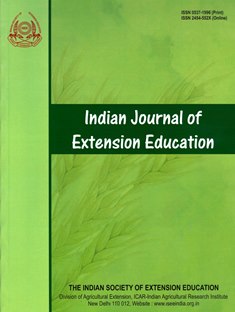Prevailing Status of Agricultural Trade between India and European Union
DOI:
https://doi.org/10.48165/IJEE.2023.59103Keywords:
EU, Agricultural trade, CAGR, CDVI, FTA, International tradeAbstract
This study analysed the current scenario of India-EU trade, composition of trade, growth and instability of agricultural commodities during the period 1997-98 to 2021-22. India’s agricultural export to the EU was US $ 4.7 billion and imported US $ 1.3 billion from the EU in 2021-22. Netherlands, Italy and Germany were three most important EU members for Indian agricultural trade. India mainly exported fishes and marine products, coffee, tea, meat, spices and cotton to the EU. Vegetable oil, raw hides, skin and leather and animal fodder were imported by India from the EU. Compound Annual Growth Rate (CAGR) and Cuddy-Della Valle Index (CDVI) for instability indicated that the total trade between India and the EU have increased consistently with annual growth rate of 6.59 per cent and instability value of 13.97. This provides impetus to policymakers to establish close trade links with counterparts of EU.
Downloads
References
Ali, J. (2007). Livestock sector development and implications for rural poverty alleviation in India. Livestock Research for Rural Development, 19(2), 1-15.
Appelbaum, S. H., Keller, S., Alvarez, H., & Bédard, C. (2012). Organizational crisis: lessons from Lehman Brothers and Paulson & company. International Journal of Commerce and Management, 22(4), 286-305.
Bai, J., & Perron, P. (2003). Critical values for multiple structural change tests. The Econometrics Journal, 6(1), 72-78. Bhutani, S. (2011). The India-EU FTA and its Implications on India’s Food and Farm Sector. Fact Sheet, 1. https:// www.madhyam.org.in/wpcontent/uploads/2014/07/Theper cent20India-EU-FTA-and-its-Implications-on-India-Food-and Farm.pdf
CBI (2021). Centre for the Promotion of Imports from developing countries, Ministry of External Affairs. What is the demand for coffee on the European market. https://www.cbi.eu/market information/coffee/trade-statistics
Cuddy, J. D., & Valle, P. D. (1978). Measuring the instability of time series data. Oxford bulletin of economics & statistics, 40(1), 79- 85.
Deepika, M. G. (2021). Export performance & factors affecting competitiveness of plantation commodities in India. Diao, X., & Li, R. (2020). Patterns of regional agri-food trade in Asia (Vol. 1921). International Food Policy Res Institute. https:/ /doi.org/10.2499/p15738coll2.133699
EU-India Agriculture Forum (2019). An initiative to empower the farmers and improving the agriculture ecosystem in India. https:/ /eife.org/wp-content/uploads/2019/05/EU-India AgricultureForum-EIAF.pdf
EXIM Bank (n.d.). Export Import Data Bank. [dataset]. Department of Commerce, Ministry of Commerce and Industry, Government of India. https://tradestat.commerce.gov.in/eidb/default.asp
FAO (2020). The State of World Fisheries & Aquaculture (2020). Sustainability in action. Rome. https://doi.org/10.4060/ca9229en Felbermayr, G., Mitra, D., Aichele, R., & Gröschl, J. (2017). Europe and India: Relaunching a Troubled Trade Relationship (No. 80). ifo Forschungsberichte.
Ganesh-Kumar, A., Roy, D., & Gulati, A. (2010). Liberalizing food grains markets: experiences, impact, and lessons from South Asia. Oxford University Press. http://www.ifpri.org/publication/ liberalizing-foodgrains-markets-0
Ghosh, A., Das, L., Pal, P. K., Sarkar, A., & Nain, M. S. (2017). Perspectives of small scale tea growing system (STGs): A study of north Bengal areas In India. Indian Journal of Extension Education, 53(4), 52-56.
Kannan, E., & Kumar, A. (2022). Dynamics of comparative advantage in export of India’s agriculture (Vol. 2116). Intl Food Policy Res Inst.
Kim, S. Y. (2022). The politics of FTAs in Asia: The role of China & implications for EU trade policy. In A Geo-Economic Turn in Trade Policy? (pp. 29-53). Palgrave Macmillan, Cham.
Kumar, A., Bareth, L., Yadav, J., & Ghaswa, R. (2021). Effectiveness of national mission on oilseed and oil palm on adoption of mustard crop interventions. Indian Journal of Extension Education, 57(3), 109–111.
Kumar, N. S., Joseph, B., & Muhammed, J. P. K. (2017). Growth & instability in area, production and productivity of cassava (Manihot esculenta) in Kerala. International Journal of Advance Research, Ideas and Innovations in Technology, 4(1), 446-448.
Leach, I., & Wilson, R. T. (2009). Higher value addition through hides and skins. FAO Diversification Booklet, 8, 36. Mir, S. A., Ojha, S. N., Ananthan, P. S., Qureshi, N. W., Argade, S. D., Gul, S., & Thangavel, V. (2022). Assessment of fisheries and management-insights from Dal Lake, Kashmir. Indian Journal of Extension Education, 58(4), 60-65.
Mir-Arguimbau, J., Flexas, M. M., Salat, J., Martín, P., Balcells, M., Raventós, N., & Sabatés, A. (2022). Severe winter conditions improve recruitment success of blue whiting (Micromesistius
poutassou), a temperate water fish species, in the NW Mediterranean sea. Progress in Oceanography, 102818. NFSM (2018). National food security mission. World scenario of vegetable oils & fats. https://www.nfsm.gov.in/ReadyReckoner/ NMOOP/NMOOPVol2.pdf
Panda, S., Ghosh, A., Das, L., Modak, S., Mondal, S., Pal, P., & Nain, M. (2021). Economics of small tea farming system (STFS): an in-depth study of North Bengal, India. Indian Journal of Extension Education, 58(1), 63–67.
Panigrahy, S. R., & Kalamkar, S. S. (2021). Intricate agribusiness in potato contract farming in Gujarat: A review. Indian Journal of Economics and Development, 17(1), 189-197.
PTI. (201, November 1). Timeline of farmers’ protest against three farm laws. The Economic Times. https://economictimes. indiatimes.com/news/india/timeline-of-farmers-protest-against three-farm-laws/articleshow/87797650.cms
Ramachandra, K. S., Taneja, V. K., Sampath, K. T., Anandan, S., & Angadi, U. B. (2007) Livestock Feed Resources in Different Agro-ecosystems of India: Availability, Requirement and their Management. National Institute of Animal Nutrition and Physiology, Bangalore.
Singh, P., & Mujumdar, A. B. (1992) Current status of feed and forage management of livestock in India. Agriculture Situation in India, 47(5), 375-382.
Thomas, L., Jha, G. K., & Pal, S. (2013). External market linkages and instability in Indian edible oil economy: Implications for self-sufficiency policy in edible oils. Agricultural Economics Research Review, 26(347-2016-17083), 185-198.
UN Comtrade (n.d.). Trade Statistics. [dataset]. Department of Economic and Social Welfare, United Nations. https:// comtrade.un.org/data
Downloads
Published
Issue
Section
License

This work is licensed under a Creative Commons Attribution-NonCommercial-NoDerivatives 4.0 International License.

